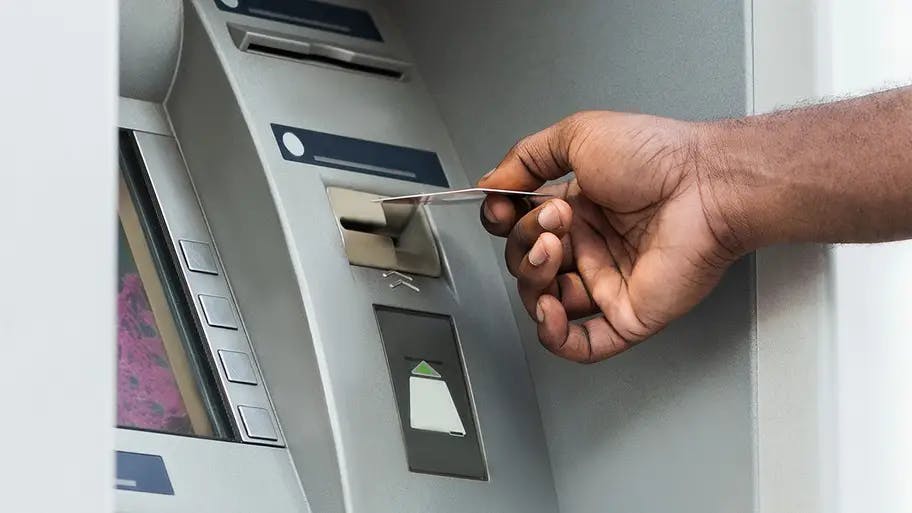

An automated teller machine (ATM) is a specialized computer that allows you to complete bank transactions without the need of a bank representative. Many ATMs are conveniently accessible any time of day or night and can be used for everything from withdrawing or depositing money to checking your account balance to transferring money between accounts.
Here we’ll delve deeper into what an ATM is, common transactions performed at ATMs and important things to know before using them.
Key takeaways
An ATM is a machine that allows you to withdraw money, deposit cash or checks, view your balance or transfer money between accounts.
Many ATMs are accessible around the clock and eliminate the need to see a bank teller for transactions.
It pays to avoid ATM fees by only using ATMs in your bank’s network.
What is an ATM?
ATMs are machines that dispense cash and allow you to make other banking transactions. An ATM typically consists of a screen, a card reader, a keypad, a cash dispenser and a printer.
ATMs can be found in many locations throughout the U.S. and the world. On-premise ATMs are located at financial institutions such as banks and credit unions, while off-premise ones are commonly offered at places like airports, grocery stores and gas stations.
Using an ATM simply involves inserting your bank-issued ATM card, entering your personal identification number (PIN) and following the prompts on the screen to complete your desired transaction.
ATMs debuted to the public in the 1960s, and Barclays lays claim to unveiling the world’s first ATM at a branch in London in 1967. The first ATM in the U.S. started dispensing cash in 1969 to customers of Chemical Bank in New York. By the end of 2022, more than 450,000 ATMs were operating in the country, according to data from research firm Euromonitor International.
Examples of ATM transactions
Various common banking transactions that are often carried out at an ATM include:
Withdrawing cash
The most common ATM transaction is the withdrawal of funds from one’s account. Banks typically impose limits on the maximum amount that can be taken out each day. This amount can vary from bank to bank, as well as among different accounts offered by a single bank.
Depositing money
Account holders can often use an ATM to deposit cash or checks. When making this type of transaction, you’ll be asked to insert the funds into a slot in the machine. When money is deposited in the form of a check, the bank sometimes might not provide you with access to the funds until the check has cleared.
Transferring funds
You may be able to use an ATM to transfer money between accounts you hold with your bank. For instance, if you wish to transfer $200 from your savings account to your checking account, this can often be done by selecting the “transfer” option at the ATM. Like balance inquiries, transferring funds between accounts is also something you can accomplish using your bank’s mobile app or website.
Balance inquiries
You can also visit an ATM to view your current account balance. This feature may come in handy if you wish to know how much you’re able to spend when using your debit card or writing a check. Alternatively, your account balance is something you can view by logging onto your bank’s mobile app or website. Knowing your balance can help you keep from overspending or overdrawing your account.
Some banks also allow customers to use ATMs to see a small list of their recent transactions (although viewing your entire account statement isn’t usually an option).
What to watch out for with ATMs
ATM fees
Using an ATM that’s not owned by your bank, or one that’s not in your bank’s network, may result in fees imposed by both your bank and the bank that owns the ATM. The combined average fee is currently at a record high of $4.73, according to Bankrate’s 2023 checking account and ATM fee study.
Ways to avoid ATM fees include only using ATMs in your bank’s network and requesting cash back when you make purchases at a grocery store or other retailer.
ATM withdrawal limits
As we’ve mentioned, banks impose limits on the amount of funds you can withdraw at an ATM each day. This can help curb fraud in the event someone has possession of your ATM card and knows your PIN. What’s more, limiting the amount per withdrawal allows the bank to manage cash movement, since each ATM only holds a limited amount of money.
Location and safety
Ways to avoid becoming a victim of crime when using an ATM include using machines that are located in well-lit public places. Use your hand or body as a shield when entering your PIN to prevent others from seeing you type it. Once you receive your cash, instead of counting it at the ATM, wait until you’re in a more private location — such as your car — to do so.
Bottom line
ATMs often conveniently provide access to cash on a 24/7 basis, without the need to see a teller or other bank representative. They also commonly offer the ability to deposit funds, check your balance and transfer money between accounts. ATMs make your cash more accessible and are quick and easy to use, once you’re aware of things like withdrawal limits and ways to avoid paying out-of-network fees.
